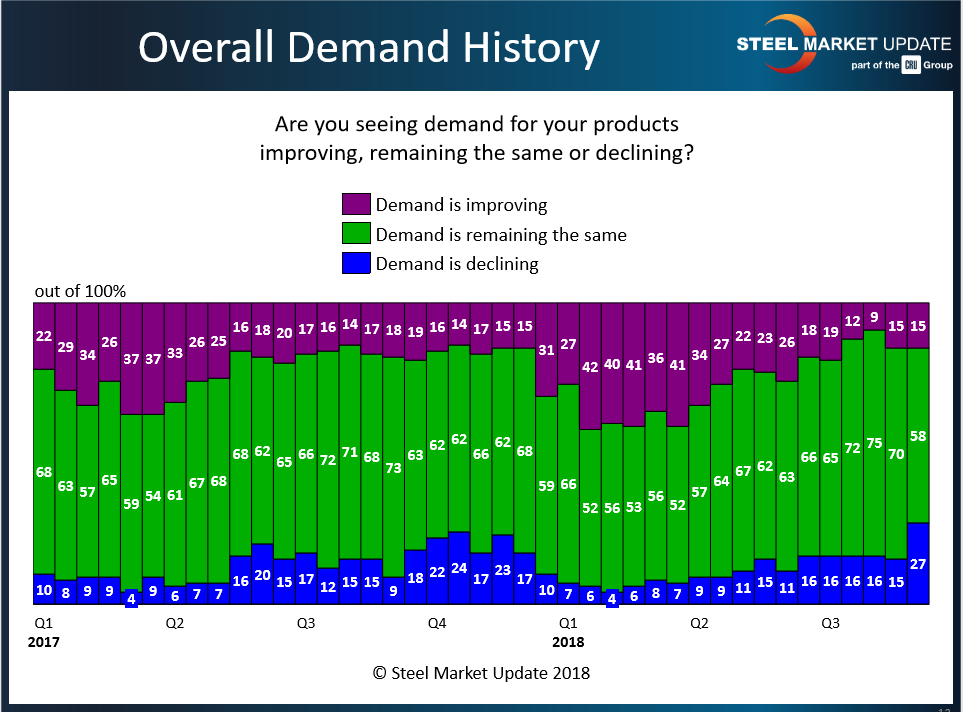SMU Data and Models

SMU Market Trends: Demand, Prices, Inventory
Written by Tim Triplett
September 7, 2018
Steel demand and prices are seeing some softening, but perhaps not enough to trigger a big inventory correction yet, report respondents to Steel Market Update’s flat rolled market trends questionnaire this past week.
About 27 percent of the steel buyers who responded believe demand for their products is declining. However, the majority, 58 percent, report that demand from their customers is unchanged. A few, 15 percent, even see improving demand.
“Demand is slightly down, but not declining overall,” said one steel executive. “This is the first time all year we have seen a falloff,” said another buyer. “It’s softening a little as customers wait to see where the market is going,” agreed a third. “Business has pulled back a little. I think people got too heavy on inventory over the summer,” observed another respondent. “As long as U.S. purchasers at OEMs have global supply alternatives, demand will continue to shift offshore,” noted yet another.


More than 70 percent of those responding to SMU’s query expect flat rolled steel prices to decline further. Nearly all of the rest believe prices have bottomed and will stay about the same.
“I see prices down $40-50 within a month, then plateauing,” said one exec. “Prices are heading lower, but some possible future tightness in supply could cause them to rebound,” commented another. “There has been a modest drop—perhaps affording us some buying opportunities,” observed one respondent. “Prices should be about the same, unless trade wars scare customers into irrational buys” said another. “Down then up then down and up. It’s a roller coaster,” another buyer commented.

Despite changes in pricing and demand, the market is almost evenly split on what to do with inventories. Fifty-three percent say they are reducing inventories in anticipation of lower prices over the next few months, while 47 percent say they are staying the course. Following are some of their comments:
• “Our inventory is already lean.”
• “The mills are running behind, so I need to have ‘buffer stock.’”
• “We’re only buying minimums. Customers are delaying all commitments as long as possible.”
• “End user customers are still buying, but they are cutting the amount to just what they need and not over committing. The same for distribution, but only for set projects.”
• “We’re reducing inventory, and so is the rest of the service center industry, which gives the impression the market has fallen further than it really has.”
• “There will be plate shortages in two months, so why lower your inventory waiting for lower prices that likely will not happen.”
• “Price is not the reason that we are reducing inventory.”
• “It’s no fire sale, but I feel less may be best.”


Tim Triplett
Read more from Tim TriplettLatest in SMU Data and Models

SMU Survey: Sheet lead times ease further, plate hits one-year high
Steel buyers responding to this week’s SMU market survey report a continued softening in sheet lead times. Meanwhile, plate lead times have moderately extended and are at a one-year high.

SMU Survey: Buyers report more price flexibility from mills
Nearly half of the steel buyers responding to this week’s SMU market survey say domestic mills are showing increased willingness to negotiate pricing on new spot orders. This marks a significant shift from the firmer stance mills held in prior weeks.

SMU Survey: Buyers’ Sentiment Indices fall
Current Sentiment Index dropped six points to +42 this week compared to two weeks earlier. It has fallen in every successive survey since reaching a 2025 high of +66 on Feb. 19.

March service center shipments and inventories report
Steel service center shipments and inventories report through March 2024.

Apparent steel supply contracts in February
The amount of finished steel that entered the US market in February receded from January’s peak, according to our analysis of Department of Commerce and American Iron and Steel Institute (AISI) data.
